
- Home
- Live Blog
- Breaking News
- Top Headlines
- Cities
- NE News
- Sentinel Media
- Sports
- Education
- Jobs

Dr. Birendra Kumar Gohain (dr.gohain@gmail.com)
The concept of ancestors’ worship is very vibrant amongst the Tai Ahoms. The ancestor worship in the household of an Ahom family, which practices the traditional Ahom religion, is called dam-puja (dam-phi or ancient worship) of the household. It is observed that the ritual of Dam Phi (ancestor-worship) in the household has connection with the wet-paddy cultivation as the Tais are rice-eaters and they choose their habitat in places in which rice grows. Rice being the staple food is important in life; so is the worship of their ancestors as they have the firm belief that their ancestors protect them in every walk of life.
The kitchen which is located in the main room of the principal house of the Ahoms which is usually situated in the north is the place where the Ahom family practising the traditional religion sets up the post for worship of the Dam (spirits of the ancestors). This post is called Dam - Khuta (the post for the spirits of the ancestors) or Pho’ kam post. It is fixed up in the west by the Mohans while the Deodhai - Bailung set it up in the east. It is said that since Mohan’s ancestor was a descendant of Moon God (Khun Tun) and Deodhai’s ancestors was a descendant of the Sun God (Khun Ban) the Dam post is located facing the east and the west respectively. The Mohan clan sleeps in the bed with their head towards the west and the Deodhai clan sleeps with their head towards the east to avoid pointing their legs towards the dam - posts. The household Dam Phi ritual is observed in the household of a priestly family on the following occasions:
1. In the Assamese month of Aghon (the first Tai month Dinching, November-December) on the occasion of Khen Khao by offering chicken, home-made rice spirit and cooked rice. It may be observed in any other month convenient to the members of the household.
2. In the month of Aghon, the first month of the Tai New Year, on the occasion of taking new rice, the festivity of Poi kin on mou (Na khowa in Assamese) is observed with offerings made to the dams of the household. Chicken, a special herb called Jabori, some special offerings in addition to the compulsory rice spirit (luuk lao) and pieces of betel nut covered by a petal of the holy flower chinkara over-wrapped with pieces of betel leaf.
3. On the occasion of Magh Bihu which is observed on the first day of Assamese Magh or 14th/15th January)
4. On Bohag Bihu (first day of the Assamese month of Bohag, 14th or 15th April), the offerings are roh (home-made rice spirit), betel nut pieces, covered by chinkara flower and wrapped over with pieces of pan leaf, borpitha (a variety of rice cake) tel diya pitha (another variety of rice cake) all home-made. Borpitha (special rice cake) is made in Bohag Bihu only.
5. On the first day of broadcasting of paddy seeds, that is, the ceremonial transplanting of rice-seedlings in the field, the offerings in the form of fried powdered sticky rice, Gur, chinkara flower, betel nut pieces wrapped up with pieces of betel leaf inside, over which the holy chinkara flower is wrapped up (kup), yam (kath-alu in Assamese, dioscorea), one piece gur (molasses), homemade rice spirit (Rohi). No rice cakes are offered.
6. On the occasion of the purification ceremony of a new born baby; on the occasion of a marriage in the household; on the tenth day of the death of a person in the household, dam phi is observed.
7. In case of any journey or start of a business or an enterprise, to prevent any misfortune or mishap, homemade rice spirit is offered to the forefathers that is called ju nlalai in Tai. Offering of homemade liquor is a must for all good occasions in the household. Except on the various stages of wet rice cultivation like sowing of the seeds, transplanting the seedlings etc. there is no Dam Phi ritual observed on the Kati Bihu.
The raised baboo platforms for the forefathers worshipped in front of the post of spirits (dam post) in the kitchen are arranged in the following order one after the other:
From left to the right while facing the dam post:
(1). The principal spirits (ghai dam in Assamese/ Chao Tung Dam in Tai), (2) the collective spirits (jakorua dam in Assamese/ Dam Likha Likhi in Tai)), (3) the ancient spirits (Chi ren dam in Tai), (4) the new spirit (na dam in Assamese/ On mou dam in Tai) of father of the head of the family and, (5) the new spirit (na dam) of mother of the head of the family. If one parent is dead, one bamboo platform is arranged.
In case the household does not have any death of children, unmarried persons, issueless parents, the raised platform for the collective spirits (jakorua dam in Assamese/ Dam likha likhi in Tai) is not required.
The Tai Ahoms celebrate the collective ancestors’ worship called Me Dam Me Phi in the last week of January every year. Here the gods of the Ahom pantheon namely Lengdon (the king of heaven), Khaokham (the god of waters), Ai-Lengdin (the god of the earth), Janshaihung (the divine preceptor),Mutkum-taikum (the Sun and Moon gods), Jachingpha (the goddess of learning), Chitlamcham (seven sons of Lengdon, Lord of Heaven), the collective spirits of the dead (Chao dam-phi) along with two evil spirits (Rakhin-Bakhin) are propitiated. Nowadays, the collective Me Dam Me Phi is observed yearly on 31st of January every year and it is a Government holiday in Assam.